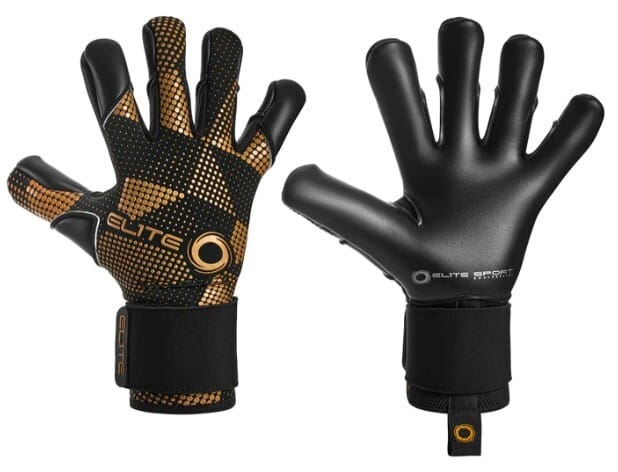- Elite Keepers Shop
- Posts
- Top Features to Look for in Artificial Grass Goalkeeper Gloves
Top Features to Look for in Artificial Grass Goalkeeper Gloves
When it comes to choosing the perfect pair of goalkeeper gloves for artificial grass, several factors come into play. Goalkeepers need gloves that not only provide excellent grip and protection but also enhance their performance on synthetic surfaces. Artificial grass, while offering a similar feel to natural grass, can be tough on gloves, making it essential to select the right features for durability and comfort. Here, we’ll discuss the top features to look for when purchasing artificial grass goalkeeper gloves.
1. Grip and Latex Type
One of the most important features to consider when choosing goalkeeper gloves for artificial grass is the grip. The type of latex used in the gloves plays a significant role in how well the gloves perform, especially on synthetic surfaces.
Latex for Optimal Performance
Goalkeeper gloves generally come with different types of latex, including soft, all-weather, and hard-wearing latex. For artificial grass, it’s essential to choose gloves with latex that can handle the roughness of synthetic turf. All-weather latex or durable latex options are excellent choices for artificial grass as they provide a solid grip while being more resistant to wear and tear.
While soft latex offers superior grip in ideal conditions, it tends to wear down faster, especially on rougher surfaces like artificial grass. Therefore, consider gloves with latex specifically designed for durability while maintaining solid control during play.
2. Fit and Comfort
The fit and comfort of goalkeeper gloves are crucial for long-lasting performance. Ill-fitting gloves can cause discomfort and affect your ability to make quick, sharp movements during matches.
Snug Yet Flexible Fit
A tight, snug fit around the fingers, palms, and wrists is essential, as loose gloves can lead to slippage and less control of the ball. On the other hand, overly tight gloves can restrict movement and be uncomfortable. Look for gloves that provide a balance of flexibility and a secure fit. Many artificial grass goalkeeper gloves offer various cuts, including flat cut, roll finger, and negative cut, allowing players to choose the fit that feels most comfortable for their style of play.
Moreover, gloves with adjustable wrist straps help ensure a secure fit and prevent discomfort. The material used for the glove’s interior lining also impacts comfort. Breathable and moisture-wicking fabrics will keep your hands cool and dry, preventing discomfort during intense play.
3. Durability and Protection
Goalkeeper gloves for artificial grass must be durable enough to withstand the constant friction and roughness of synthetic surfaces. Artificial turf can cause excessive wear on the palms, leading to quicker degradation of the glove material. Therefore, durability is a key feature to look for.
Reinforced Palms and Fingers
Goalkeeper gloves for synthetic grass should feature reinforced palms and fingers that can handle the abrasion from turf. Some gloves come with additional padding or protection in these areas to enhance durability without sacrificing comfort. Padding also provides added protection for the fingers and hands during high-impact plays, such as diving or catching high balls.
Durability-enhancing features, such as rubberized sections or extra layers in high-contact areas, can prolong the lifespan of your gloves, especially on abrasive artificial grass.

4. Breathability and Moisture Control
Goalkeeper gloves can quickly become damp and sweaty, which affects both comfort and performance. Artificial grass matches, in particular, can be demanding on the hands due to the intensity of play and environmental conditions. Gloves that promote breathability and moisture control are vital to maintaining grip and comfort throughout the game.
Moisture-Wicking Fabrics
Gloves made with breathable materials, such as mesh or perforated panels, allow air circulation to keep your hands cool and dry. Moisture-wicking fabrics, commonly found in the glove's interior lining, help to keep sweat at bay, ensuring that your gloves remain comfortable throughout the match. These features are especially beneficial when playing under warm conditions or during extended game time.
5. Protection Against Injuries
As a goalkeeper, you’re constantly using your hands to block, catch, and throw the ball, which exposes you to potential injuries like finger hyperextension or sprains. A key feature to look for in artificial grass goalkeeper gloves is protective elements that reduce the risk of hand injuries.
Finger Protection and Reinforced Padding
Some gloves come equipped with special protection systems, such as spines or protective inserts, that safeguard your fingers from hyperextension or trauma during intense play. These protection systems are particularly important for goalkeepers who dive frequently or engage in close-contact play.
The padding in the palms, knuckles, and fingers also contributes to injury prevention by absorbing impact during diving and blocking. When selecting goalkeeper gloves for artificial grass, make sure they have ample protection in high-impact areas while allowing flexibility for natural hand movement.
Selecting the right goalkeeper gloves for artificial grass is essential for optimizing performance and reducing wear. By considering the key features such as grip, fit, durability, breathability, and protection, you can ensure that your gloves enhance your game rather than hinder it. With the right pair, you’ll be able to confidently defend your goal on synthetic turf, knowing that your gloves are designed for maximum comfort, durability, and protection.